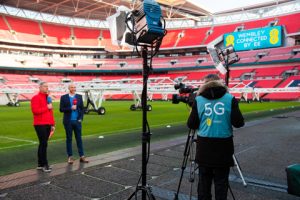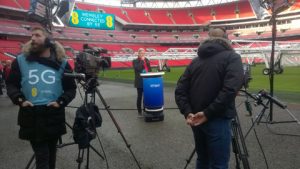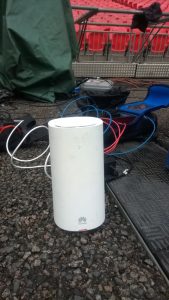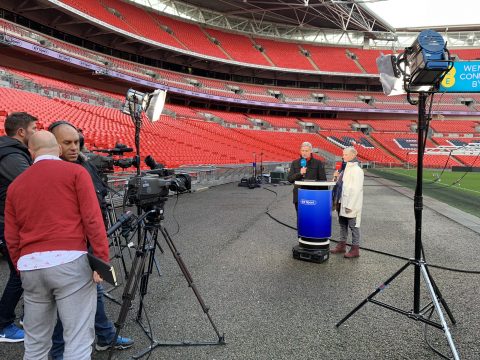Live from London: EE and BT Sport achieve world first with 5G broadcast using remote production
In a world first, BT Sport and EE have successfully carried out a live broadcast over 5G using remote production, delivering a two-way transmission from Wembley Stadium to London’s ExCeL exhibition centre.

BT Sport presenter, Matt Smith, and Matt Stagg, director of mobile strategy, at Wembley Stadium taking part in the first ever remotely produced live broadcast over 5G
Showcasing the capabilities of 5G technology for the world of sports broadcasting, BT Sport’s Jamie Hindhaugh, chief operating officer, alongside presenter Abi Stephens, spoke live from ExCel in East London to BT Sport’s Matt Stagg, director of mobile strategy and lead of EE strategy for delivering 4G and 5G networks for the media and broadcast industries, with Matt Smith, presenter, both of whom were pitch-side in Wembley Stadium, North London. All production for the live transmission was carried out at BT Sport’s base in Stratford, East London.
The demonstration was designed to illustrate the potential opportunities that 5G can bring to sports broadcasters. BT Sport stated it will use 5G to increase coverage of sports as well as greatly improve efficiencies, from financial to creative.
Speaking to SVG Europe, Hindhaugh said: “What we’re trying to show is the opportunities around remote production. We’re not giving up on 4G, but 5G almost combines fibre and 4G, into virtualised fibre; you have the surety of signal with the flexibility of mobile.

At Wembley Stadium BT Sport’s crew with presenter, Matt Smith, preparing for broadcasting over 5G, with the production crew working remotely at BT Sport’s studios in Stratford
He added: “5G will next season enable BT Sport to deploy the most advanced remote production of any broadcaster. It will allow us to cover more live matches from more leagues and competitions, and to bring fans highlights action closer to the final whistle than has ever been done before in the UK.”
Hindhaugh continued: “This is the world’s first remotely produced broadcast over 5G. It takes us back to the heart of BT Sport. BT Sport has a rich history of the latest broadcast innovations, whether it’s UHD with Dolby Atmos or 360 virtual reality. And then we look at 5G; the thing about remote production is the creativity it enables. You can start covering things in a different way, and it also enables you to drive efficiencies. [5G] gives teams, through remote production, the ability to work on more, and different sports. You couldn’t expect someone to cover three games in a day from a truck, but you can with 5G.”
In addition, the FA-recognised EE Wembley Cup, kicking off this Sunday (25 November) at 2pm, will be the first sporting event broadcast live using 5G remote production. The event, featuring YouTube’s biggest footballers alongside international football legends, will be delivered over EE’s 5G network live from Wembley Stadium and then shown live on the channel of YouTube star Spencer Owen.
Normally the first thing your team asks is “can we?”. With 5G, it’s “where do you want to go?”
Andy Beale, chief engineer at BT Sport, said: “[With 5G] you can get shots you haven’t ever done before, from the changing rooms to walking in the tunnel; it really does unlock it. People are really still finding out the possibilities [that 5G will provide]; it’s not just about doing things more efficiently, it’s doing things you haven’t even thought of doing before.”

Referring to sports broadcasting, Hindhaugh added: “Normally the first thing your team asks is “can we?”. With 5G, it’s “where do you want to go?”.”
The transmission used EE’s 5G test network in the stadium, plus a first-generation 5G encoded dongle from Huawei. The test network used EE’s 3.4GHz spectrum from its 5G antenna in the stadium, connected to a 10Gbps backhaul link.
With a throughput of 75MBps at Wembley, feeds from three cameras at 25MBps each were relayed through the Huawei 5G encoder to the 5G cell in the stadium. From there the transmission passed onto the EE backhaul network, and then to the internet.

Huawei’s first-generation 5G encoded dongle hard at work in Wembley Stadium
Going forward, EE will use 5G network slicing technology to create a broadcast grade network for clients, providing the guaranteed latency, bandwidth and quality required for live broadcast. The company stated 5G will enable broadcasters to send match footage back to base within minutes, opening up more coverage possibilities and reducing costs by reducing the number of technicians required at each game.
Stagg stated: “What we can do with 5G is network slicing, where you build a virtual network so you can use the properties of 5G but outside the consumer network. We can give you 100GBps and it’s sewn up; you don’t need to worry about latency,” he said, giving an example of what will be possible with 5G for broadcasters. “It’s just about getting the best connectivity you can get to enable creativity.”
From Wembley Stadium, SVG Europe’s Heather McLean was able to become one of the first people to ever take part in a 5G broadcast using remote production. Take a look at this video here of McLean speaking with BT Sport presenter, Matt Smith.

SVG Europe’s Heather McLean taking part in BT Group’s world first broadcast over 5G with remote production, speaking with BT Sport presenter, Matt SMith
BT Group is working hard to get 5G up and running for 2019. The BT Technology team is virtualising elements of the core network for 5G rollout in 2019 and is building a next-generation 5G core in line with the next stage of global 5G standards, with virtualised network functions on a cloud-native infrastructure, creating the basis for a smart and fully converged agile network. The BT 21CN backbone network is Petabit-class, and will ensure the future-proofed scale required to enable a world-leading 5G experience.
Earlier this month, EE announced that nine 5G trial sites went live across East London. The trial has so far encompassed every element of building a new 5G network, from obtaining planning permission and access agreements, through to managing power outputs. The trial will go on to assess the customer experience of the new 5G spectrum.
A week later, the mobile operator stated it is switching on 5G sites in 16 UK cities in 2019. The first launch cities will be the UK’s four capital cities – London, Cardiff, Edinburgh and Belfast – and Birmingham and Manchester. Throughout 2019 EE will also be introducing 5G across the busiest parts of ten more UK cities: Glasgow, Newcastle, Liverpool, Leeds, Hull, Sheffield, Nottingham, Leicester, Coventry and Bristol. EE will launch with multiple smartphone partners, as well as an EE 5G Home router with an external antenna, to showcase the power of 5G for broadband.
EE is the lead partner of Wembley Stadium. Since the partnership kicked off in 2014, EE has introduced several technological advancements to the stadium, including delivering significant network upgrades preceding the latest 5G implementation, ensuring fans can stay connected during events. EE also worked with the Wembley team to deliver the first official Wembley app.
